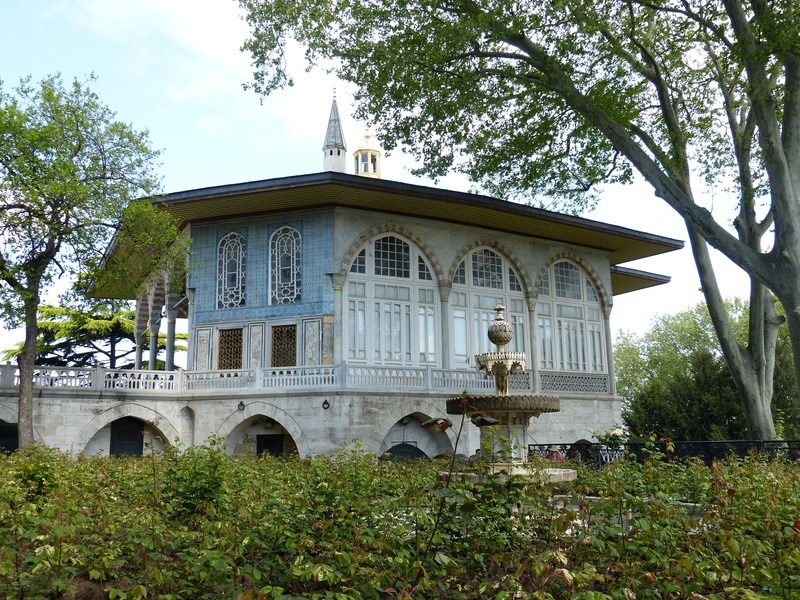Topkapi Palace is the oldest remaining palace of the Ottoman period in Istanbul. It was the second to be built, after the one in the Beyazit area, of which unfortunately nothing remains. Its construction began just 20 years after the conquest of Istanbul, between 1466 and 1478, in what was then the newly conquered capital of the new empire.
The Topkapi Palace covered an area of 700,000 square meters, today it covers a total of 80,000 m2.
The Ottoman Empire, which controlled Southeastern Europe, the Middle East and most of North Africa at the height of its power in the 16th and 17th centuries, was governed from the Topkapı Palace and its great court, which almost symbolizes this expansion, for 380 of its 600 years of existence.
History
It was separated from the rest of the city by the Sur-i Sultani, built by Mehmed II (the Conqueror) on the mainland, and by the Byzantine walls on the shore. As the palace was used to rule, educate and as the residence of the sultan, it is divided into two sections that reflect this use. The first of these sections is the Birun, which housed the service buildings in the first and second atria; the second is the Enderun, which includes the sections related to internal organization.
The Harem section was built between 1574 and 1595, and the residents of the Harem moved there from the former Beyazıt Palace. Directly inside the Harem were the quarters of the Chief Eunuch, and one floor up was the princes’ school. Over time, the Enderun school, the chief physician’s quarters, the Enderun pharmacy, the mansions in the inner atriums, and the summer mansions on the banks of Sarayburnu (the tip of the Seraglio) were built, the kitchens and stables were expanded, and new libraries and mosques were added.
The population of the palace, which was about 750 during the reign of Mehmed II, gradually increased to about 5,000 in normal times, and 10,000 during vacations and other extraordinary events, during the 19th century. As the Topkapı Palace grew in size and function, it began to reflect the institutionalization of the Ottoman government. The dramatic events that took place during this rich history make Topkapı Palace a rare example among the world’s museums that has survived to the present day with all its historical richness.
The palace was originally known as Saray-i Cedid-I Amire, but it became Topkapi Palace during the 19th century, after one of the gates in the city wall. It overlooks the city from the tip of the historic peninsula at the entrance to the Golden Horn, offering one of the most beautiful views of the city, from which you can see:
- The Bosphorus,
- The Golden Horn,
- Both banks,
- The Sea of Marmara,
After the conquest of the city by Mehmet II, the Topkapi Palace served as the main palace for nearly 600 years, until Abdulmecid built the Dolmabahce Palace to house the administration of the empire. Unlike European palaces, Topkapi Palace is an organic complex that contains many kiosks, gardens and spaces in its huge area, which at the time housed about ten thousand men, between janissaries and viziers.
The Topkapı Palace, used by the Ottoman dynasty until it moved to the Boğaziçi palaces during the 19th century, never lost its importance. It was repaired from time to time, and the section of sacred relics, visited by the sultan and his family during Ramadan, was regularly maintained.
The Topkapı Palace was first opened to visitors as a museum during the reign of Abdülmecid (1839-1861). Over time, the presentation of the Treasury of Topkapı Palace to foreigners became a tradition. Abdülaziz (1861-1876) built showcases for this purpose, and the treasure began to be displayed to foreigners in these showcases.
After the foundation of the republic, the Topkapı Palace was turned into a museum by order of Atatürk in 1924. While at first only a few sections were open to visitors, almost the entire palace can be visited today. For example, weapons dating from the 7th to the 20th century that are part of the palace collection are displayed in the treasury building, horse harnesses and royal carriages belonging to the palace are displayed in the imperial stables. Ceramic, porcelain, glass and metal tableware used in the palace can be visited in the palace kitchens. Sacred relics belonging to the Prophet Muhammad and some caliphs are displayed in the Hırka-i Saadet section. The Fatih Pavilion houses objects such as the Spoon Maker’s Diamond and the Topkapı Dagger, which have been the subject of many novels and films. The ceremonial and everyday dresses worn by the sultans are on display in the Seferli Barracks. The harem and mansions belonging to the sultans are also among the sections of the palace that must be seen.
Since the time of the Republic, when the palace was transformed into a museum in 1924, Topkapi Palace has become one of the most attractive palace-museums in the world. The most attractive exhibition rooms of the palace are :
28 towers distributed on the wall surrounding the Topkapi Palace. The Islamic holy relics and Chinese porcelains. The Sanctum Sanctorum (Harum), or the inviolable place where the royal women resided.
- – The costumes of the sultan,
- – Divan,
- – Kitchens,
- – Kiosks,
- – Baghdad,
- – Revan,
- – Sofa,
- – Mecidiye,
Possibilities to eat and rest with a beautiful view for visitors.
How to get to the palace
The palace is open from 9am to 6pm, closed on Tuesdays
Entrance fee: 320 TL (18 €), free under 12 years old
https://www.millisaraylar.gov.tr/en/saray-kosk-ve-kasirlar/topkapi-sarayi
Cankurtaran, 34122 Fatih/İstanbul, Turkey
https://goo.gl/maps/qQBbui9uAPtXgiGcA





